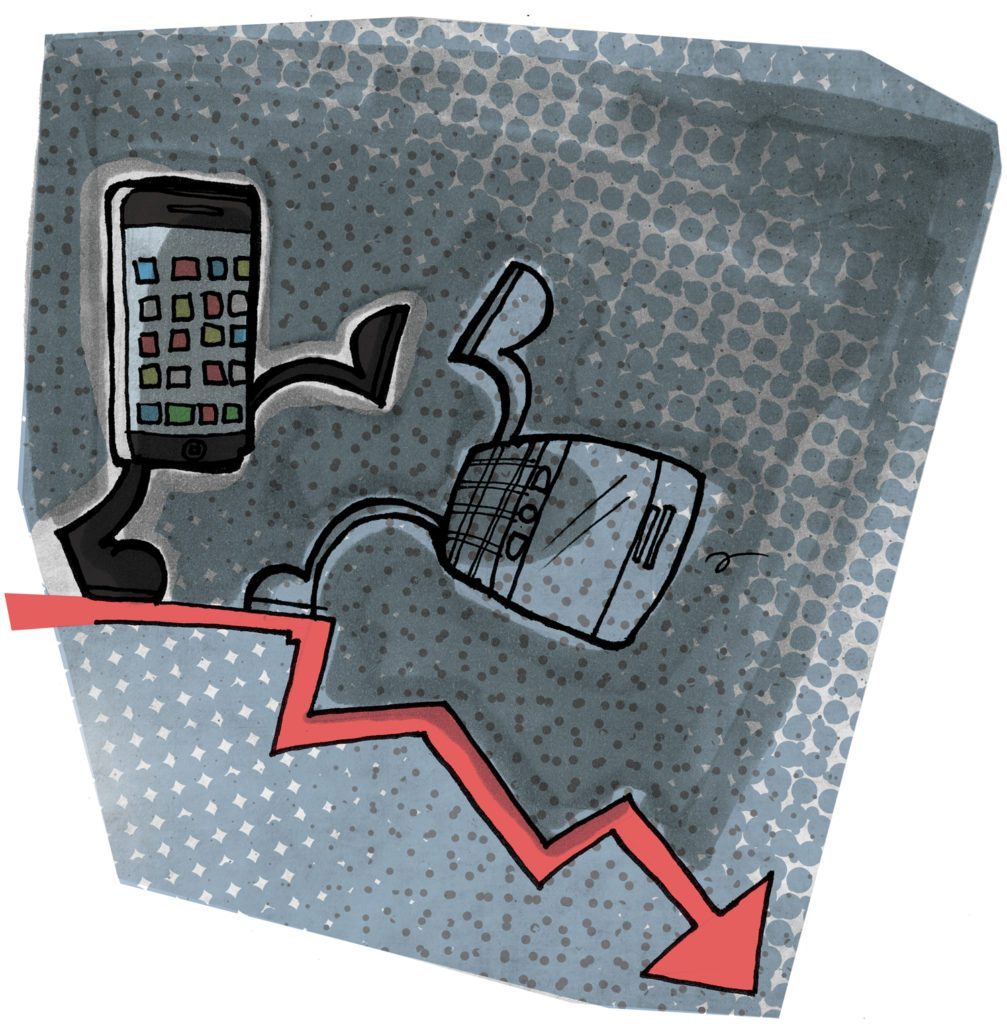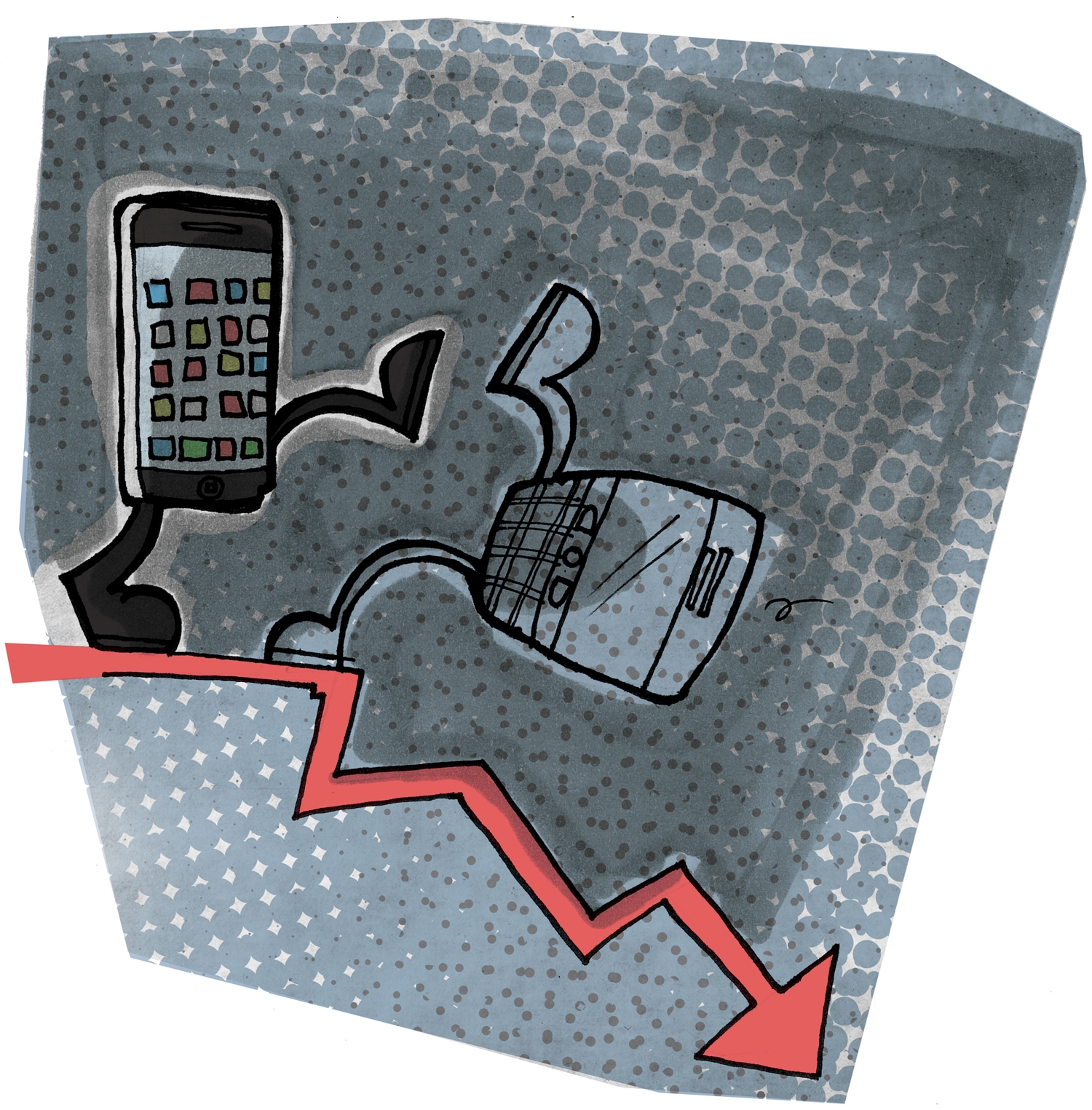After a decade of dominating the market in Canada, RIM falls into recovery

Michael MacDonald
Contributor
In 1999, Research in Motion (RIM) gave birth to the iconic BlackBerry. Less than a decade after launching their first mobile phone, the Canadian telecommunications firm sat at the helm of the high tech world, briefly holding status as Canada’s largest company.
The ascent of RIM’s BlackBerry redefined an entire industry, and the cultural impact of two-way emailing through the mobile phone is immeasurable, but RIM’s fall from grace has been just as dramatic. A string of uninspired products and a failure to keep pace with competitors has provoked embittered investors who are demanding seismic shifts in the company’s direction. On January 22, co-CEOs Jim Balsillie and Mike Lazaridis finally ceded to this pressure and stepped away from the company.
With any rise-and-fall story one question stands out from all others: how could RIM, once a telecommunications giant, lose
75 per cent of its market value in less than 12 months? How could such an iconic brand fall so far, so fast?
The origin story of RIM is recounted as business folklore.
Jim Balsillie and Mike Lazaridis are the two precocious entrepreneurs from Waterloo, Ontario who risked everything on an idea. Convinced that he could make it as an entrepreneur, Lazaridis dropped out of the University of Waterloo two months shy of graduation and incorporated RIM. Balsillie joined the upstart a few years later, and invested $250,000 of his life savings into the small company that had thus far paid the rent with business grants from the government of Ontario. The partnership was dynamic, and every early gamble paid off. RIM feasted on the lion’s share of the smartphone market for years, hitting a high water mark of over 20,000 employees and a stock valuation of almost $150 per share.
On January 9, 2007, everything changed when a man walked across the stage of a convention centre in San Francisco—Steve Jobs introduced the iPhone. The Apple product had touch screen technology, an intuitive operating system, and the ability to download thousands of different applications.
These “apps” were truly revolutionary. Brian X. Chen, author of Always On: How the iPhone Unlocked the Anything-Anytime-Anywhere Future—And Locked Us In, says that “the iPhone isn’t just a smartphone, but also a medical device, a musical instrument, an education tool, and thousands of other apps. A single app has potential to compete with an entire industry and impact our culture.”
According to an anonymous (alleged) ex-RIM employee, the day after Steve Jobs launched the iPhone, RIM held a series of closed door meetings at their company headquarters in Waterloo. In one such meeting, a team of RIM engineers cracked open the iPhone, hoping to unlock any mysteries held within. The Apple product was eons ahead of anything their company had in development.
In November of 2008, RIM responded with the BlackBerry Storm, which they hailed as their leading-edge alternative to the iPhone. Critics called it a dud. The electronics review website CNET emphasized that the Storm suffered from “sluggishness and buginess,” and in the words of New York Times technology columnist David Pogue, “I haven’t found a soul who tried this machine who wasn’t appalled, baffled or both.”
The Storm sold 500,000 units in its first month, while the iPhone 3G sold 1,000,000 units in its first weekend.
Russell Belk, professor of marketing at the Schulich School of Business, believes that RIM made the mistake of adopting a “me too” approach to product development by simply churning out a shoddy facsimile of the iPhone. According to Belk, the BlackBerry Storm was “overtaken by other devices that simply worked better and looked better.”
In the summer of 2009, RIM launched an electronic app store—a full two years after Apple pioneered the concept. “Blackberry App World” launched with only 1,000 apps, which paled in comparison to the 50,000 provided by Apple. This persisting disparity was labeled the “app gap.”
By early 2010, a litany of cracks had formed in RIM’s business model. The stock was not in free-fall, but it was in a steady decline. BlackBerry’s brand equity was fending off the truly negative forecasts, but even the most steadfast of RIM’s faithful were anxiously ruminating over the future.
In January of 2010 Apple released their first tablet computer: the iPad. The new product had a large touch screen display, a seamless operating system and an intuitive user interface. The new product was for consumers who wanted something more powerful than a smartphone, but more portable than a computer. The iPad shattered industry expectations and created an entirely new class of product, once again coercing RIM into playing catch up.
RIM responded with its own tablet, the BlackBerry Playbook. To reverse the company’s fortunes this tablet needed to be a home run—it wasn’t. The Playbook could not run calendar applications, display contact information, or send emails unless it was electronically bridged with a BlackBerry phone. The technology-focused news publication The Verge published a review by Joanna Stern. “I can’t think of a single reason to recommend this tablet over the iPad 2,” wrote Stern. After six months on the market, The Playbook captured only 1.1 per cent of the tablet market, barely creating a ripple.
In October 2011, a three-day service outage affected millions, and shook consumer confidence. That same year, 2,000 RIM employees received layoff notices, and the company declared $485 million in write-off losses stemming from five million unsold Playbooks. On January 22, 2012, co-CEOs Jim Balsillie and Mike Lazaridis walked away from the company they built.
Success breeds hubris, and for almost a decade RIM dominated the smartphone market. They developed unshakable confidence in their idea of what a smartphone should look like, and analysts agree that these rigid perceptions stifled creative thought. Their failure to adapt led to four years of sagging stock prices, lost market share, a string of uninspired products, and a tattered reputation.
Today RIM stock is trading at $17 per share, while Apple stands at $420 per share. Many are forecasting the demise of the Waterloo firm, but these judgments are hasty. Barely a decade ago Apple was on the verge of bankruptcy, and today it is one of the most profitable companies in the world. The ebb and flow of technology markets are volatile, and the price of a stock will fluctuate in unison with the confidence of the public. Today a new CEO sits at the helm of RIM, and new hardware and networks are due for release later this year—one way or another, things will change.
In an interview with CNN, the late Steve Jobs said that “Innovation distinguishes between a leader and a follower.” When RIM released a pager the size of a small brick they pioneered interactive emailing, and this left an indelible mark on the world. On January 9, 2007, the iPhone left its own mark, and on this day Apple’s industry leadership began to crystallize, while RIM started to settle into the role of a follower. If RIM keeps following it will fail, but if the company is bold enough to lead, there is still hope.


